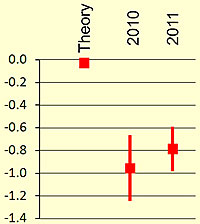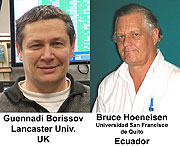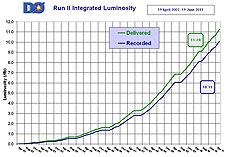| Thursday, June 30, 2011 |
| Subscribe | Contact Fermilab Today | Archive | Classifieds |
Result of the Week
|
DZero updates tantalizing muon-antimuon resultThe Standard Model predicts a value near zero for one of the parameters that is associated with the difference between the production of muons and antimuons in B meson decays. The 2010 and 2011 measurements are presented here with their uncertainty (the vertical bars). The two results are definitely different from zero and consistent with each other. The newer measurement has improved precision, as demonstrated by the shorter red bars. DZero has recorded a luminosity of 10.11, in unfamiliar units called inverse femtobarns. This analysis uses about 90 percent of the data recorded by the DZero experiment thus far, a testament to the analyzers' industry. The DZero collaboration would like to acknowledge the efforts of the Fermilab Accelerator Division, without which this analysis would not be possible. About a year ago, DZero published a tantalizing new result in which the universe unexpectedly showed a preference for matter over antimatter. This afternoon, at 4 p.m. in One West, the DZero collaboration will present an update in a seminar that is geared toward particle physicists. The 2010 measurement looked at muons and antimuons emerging from the decays of neutral mesons containing bottom quarks, which is a source that we have long expected is a fruitful place to study the behavior of matter and antimatter under high-energy conditions. The result was extremely exciting: The question of why our universe should exist solely of matter is one of the burning scientific questions of our time. Theory predicts that matter and antimatter was made in equal quantities. If something hadn't slightly favored matter over antimatter, our universe would consist of a bath of photons and little else. Matter wouldn't exist. In 2010, we found a 1 percent difference between the production of pairs of muons and pairs of antimuons in B meson decays at Fermilab's Tevatron collider. Like all measurements, that measurement had an uncertainty associated with it. Specifically, there was about a 0.07 percent chance that the measurement could come from a random fluctuation of the data recorded. That's a tiny probability, but when you look at thousands of measurements, you expect to see the occasional rare fluctuation that turns out to be nothing. Scientists are a cautious bunch and require a higher standard to claim a discovery. For a measurement of the level of certainty achieved in the summer of 2010, the best we'll claim is that we have evidence for an unexpected phenomenon. A claim of discovery requires a higher level of certainty. During the last year, DZero has taken more data and we have refined our analysis techniques. In addition, other scientists have raised questions and requested additional cross-checks. For instance, we were asked to verify that we are certain that the muons are actually coming from the decay of B mesons rather than some other source. Now, after incorporating almost 50 percent more data and dozens of cross-checks, DZero scientists are even more confident in the strength of our result. The probability that the observed effect is from a random fluctuation has dropped quite a bit, and now is only 0.005 percent. The improvement is what you'd expect if the effect is real, but the uncertainty associated with our result is still too high to claim a discovery. For a discovery, we require an uncertainty of less than 0.00005%. If the earlier measurement were a fluctuation, you'd expect the uncertainty to grow, not get smaller. Our new result suggests that DZero is hot on the trail of a crucial clue in one of the defining questions of all time: Why are we here at all? — Don Lincoln |


